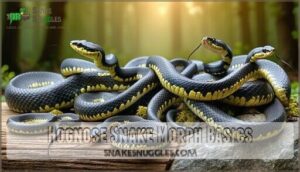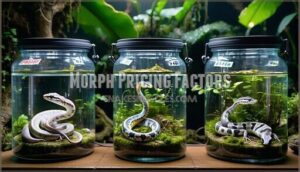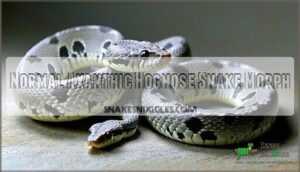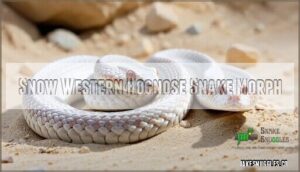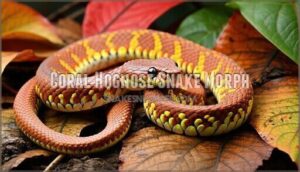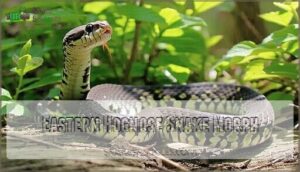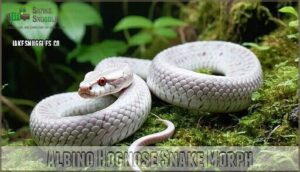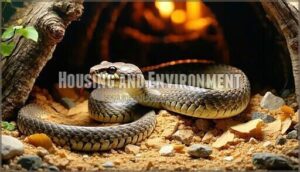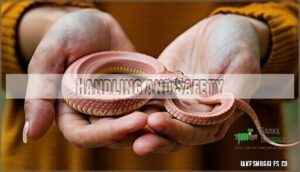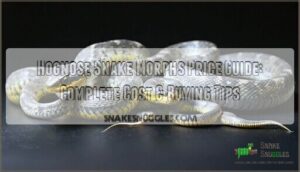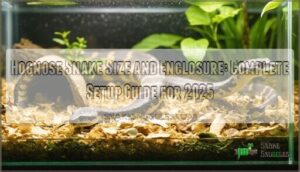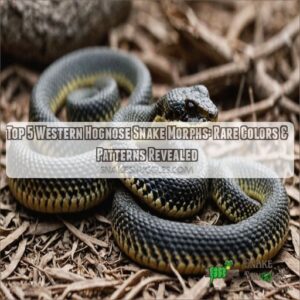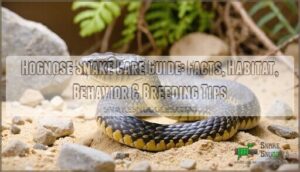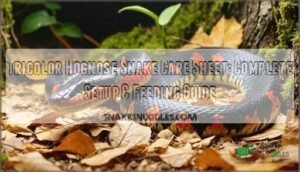This site is supported by our readers. We may earn a commission, at no cost to you, if you purchase through links.
 With the hognose snake morphs complete guide, you’ll find clear answers to nearly every question these charming snakes spark.
With the hognose snake morphs complete guide, you’ll find clear answers to nearly every question these charming snakes spark.
You’ll see how morphs like albino, axanthic, and snow bring a splash of color to the realm of Hognose snakes.
Prices walk up and down, much like these nosy reptiles exploring their enclosure—factors like rarity, age, and genetics all play a part.
Learn about proper housing, feeding, and health tips so your scaly buddy stays in tip-top shape.
Thinking about breeding or keeping morphs? There are rules for that, too.
Stick around for quirky facts and smart advice ahead.
Table Of Contents
- Key Takeaways
- Hognose Snake Morph Basics
- Morph Pricing Factors
- Hognose Snake Morph Examples
- Caring for Hognose Snake Morphs
- Breeding Hognose Snake Morphs
- Frequently Asked Questions (FAQs)
- What is the rarest morph of a hognose snake?
- What is the best setup for a hognose snake?
- What is a toxic hognose morph?
- What is a ghost hognose?
- How do you identify a healthy hognose snake morph?
- What are the most common morph-related health issues?
- How do you safely introduce new morphs to an existing collection?
- What signs indicate stress in hognose snake morphs?
- How do you acclimate a hognose morph to a new enclosure?
- Conclusion
Key Takeaways
- You’ll find that hognose snake morphs come from unique genetics, giving them a wide variety of colors and patterns to choose from.
- Prices for morphs change fast based on rarity, age, sex, and bloodlines, so always check the details before you buy.
- Caring for morphs takes the right enclosure setup, proper feeding, and regular health checks to keep your snake thriving.
- If you want to breed or own morphs, you need to check local laws and permits to stay on the right side of the rules.
Hognose Snake Morph Basics
You’ll find that hognose snake morphs are groups with special colors or patterns created through genetics.
These morphs let you see how much variety nature and breeders can bring to a single species.
What is a Hognose Snake Morph
When you talk about a hognose snake morph, you’re diving into the fun world of snake genetics.
Step into snake genetics and discover vibrant, one-of-a-kind patterns shaped by nature and breeders alike.
A morph means a snake shows unique Visual Traits thanks to Genetic Variation.
These changes come from Selective Breeding and Trait Inheritance.
Think of it as a pattern or color remix—morph types that make every hognose snake morph stand out in a reptile morph guide, showcasing Genetic Variation.
Types of Hognose Snake Morphs
When you start exploring hognose snake morphs, you’ll spot lots of wild hognose colors and pattern mutations.
There are classic morph types like albino, anaconda, and axanthic—each with their own eye-catching look.
Some, like the rarest morphs or the newest emerging morphs, stand out even more, and snake genetics create endless mixes, keeping collectors on their toes.
Certain morphs, such as the Arctic, may exhibit unique coloration patterns.
How Many Species of Hognose Snakes Are There
You’ll find three main hognose species in North America: eastern hognose, western hognose, and southern hognose.
Each has its own species identification and habits. Their geographic distribution ranges from sandy plains to wooded areas.
Snake classification helps show their evolutionary history. Conservation status and hybridization potential differ, so it’s helpful to know which hognose species lives near you, considering their conservation.
Morph Pricing Factors
When you look at hognose snake morph prices, you’ll see that things like rarity, age, sex, and genetics all matter.
The more unique or rare a snake is, the more you can expect to pay.
Morph Rarity and Price
As you explore the wild world of hognose snake morphs, you’ll find that morph rarity plays a big part in morph pricing.
Strange colors and marked lines can fetch thousands, especially when breeding difficulty and genetic diversity are involved.
Market demand, morph availability, visual appeal, and bloodline value all tussle for attention, making price comparison and price volatility common.
Age and Size Impact
Between the lines of snake shopping, age and size sway a hognose morph’s price tag fast.
Here’s the rundown:
- Hatchling prices are lowest—you’re paying for a baby with a long snake lifespan ahead.
- Juvenile costs rise with growth rate and size variations.
- Adult value peaks because you get a proven survivor with continued growth.
Age impact matters! Understanding the pricing of hognose morphs is similar to the ball python morph market, where prices vary greatly, and it’s about finding the right snake lifespan and size.
Sex and Pricing
A hognose snake’s sex can tip the scales on morph pricing.
Females hold more value thanks to their breeding potential, pushing morph demand and shaping market trends.
Price comparison shows females typically cost $50–$200 more.
Maturity pricing also kicks in—adult females attract higher offers due to gender investment.
Sex ratios matter; rare female morphs spark bidding wars.
Genetics and Bloodlines
If you want a hognose that stands out and keeps value, genetics and bloodlines matter as much as sex.
Let the right genetics and strong bloodlines turn your hognose into a true collector’s gem.
Smart breeders look for:
- Proven genetics and strong genetic inheritance from documented bloodlines
- Good genetic diversity through outcrossing programs to avoid problems
- Knowledge of recessive genes, dominant genes, and codominant genes
Bloodline documentation helps you spot rare recessive traits, which is crucial for understanding recessive genes.
Hognose Snake Morph Examples
You can find many different hognose snake morphs, each with unique colors and patterns. This section shows how common types like Albino and Coral look and what makes them special.
Normal Axanthic Hognose Snake Morph
From price factors, let’s slide over to the Normal Axanthic hognose—a true grayscale beauty.
This hognose snake morph stuns by eliminating yellow, thanks to recessive genetics, giving it striking scales with bold dark spots.
Its snake coloration is clean and sharp.
One example of a similar effect in ball pythons is the combination of albino and axanthic genes, which creates the stunning Snow ball python.
If you like a no-nonsense look, axanthic hognose morphs bring cool style to any snake collection.
Snow Western Hognose Snake Morph
If the normal axanthic morph caught your eye, the snow hognose snake is pure winter magic.
Snow genetics blend albino and axanthic hognose traits, creating a western hognose with white scales, red eyes, and faint salmon saddles.
Talk about breeding complexity! Here’s what makes the snow morph stand out:
- White scales
- Salmon saddles
- Red eyes
- Breeding challenge
- Popularity
Coral Hognose Snake Morph
If you thought the Snow morph was cool, wait until you meet the Coral.
This hognose snake morph shows off wild color intensity and unique pattern variations, thanks to its complex coral genetics.
The Coral’s popularity keeps market demand high, but breeding challenges make each one a treasure.
These snakes can be quite costly, especially rare color variations.
Check out this quick peek:
| Feature | Description | Impact |
|---|---|---|
| Coral Genetics | Complex inheritance | Rare morph |
| Color Intensity | Bold hues | Eye-catching |
| Breeding | Challenging | High value |
Eastern Hognose Snake Morph
Eastern hognose snakes stand out in the realm of hognose snake morphs thanks to their unique genetics and wild coloration.
Their natural leafy brown and black spots can show regional variations, making each snake’s look a surprise.
Popular in eastern conservation efforts, these snakes do well in captive breeding projects.
Eastern hognose color variations keep collectors curious and enthusiastic about snake morphs.
Albino Hognose Snake Morph
After looking at Eastern hognose patterns, let’s glance at the albino hognose.
This unique hognose snake morph stands out for its lack of melanin, thanks to Albino Genetics.
With bright red eyes, the Red-Eyed Trait is sure to catch yours.
They’re sensitive to light, but their visual appeal makes them popular.
Price variation depends on many genetic traits in snake morphs.
Caring for Hognose Snake Morphs
You’ll need to know the basics to keep hognose snake morphs healthy and safe. This care section covers their housing, food, health, and best ways to handle them.
Housing and Environment
Once you’ve picked your favorite morph, it’s time to get the setup right. A good enclosure size keeps your hognose comfy. Remember a snug hide beats a fancy castle.
Here’s what matters:
- Proper enclosure size
- Steady temperature gradient
- Solid humidity levels
- The right substrate choice
- Fun enrichment ideas
Selecting the right enclosure is fundamental for their well-being. A snug hide and the right environment are crucial, making the right substrate choice essential for your hognose snake.
Feeding and Nutrition
In regards to feeding hognose snakes, focus on matching prey size to the snake’s mouth, and set your feeding frequency based on age.
Hatchlings need food weekly, while adults eat every 10–14 days.
Track rodent size and try bulk discounts to manage food costs.
Proper feeding is vital, so consider reliable food sources for your snakes.
Hydration needs matter, and supplementation helps, but watch for obesity.
Here’s a table for quick tips:
| Factor | Best Practice |
|---|---|
| Prey Size | Just bigger than head |
| Feeding Frequency | Hatchlings: weekly; adults: biweekly |
| Supplementation | Vit/min for growing snakes |
Health and Hygiene
Stay on top of hognose health by rolling up your sleeves and keeping things spick-and-span.
From time to time, you’ll want to:
- Clean the enclosure often for disease prevention.
- Quarantine new snakes using proper protocols to stop parasites.
- Watch for common ailments like Shedding Issues; regular health verification and visits to an exotic vet keep snake health strong, which is crucial for overall snake health.
Handling and Safety
Handle your hognose with slow, gentle movements, never grabbing from above.
Safe handling keeps bite risk low, since hognose snakes prefer defensive displays over biting.
Always wash your hands after snake handling; good hygiene practices protect both your snake’s health and your own.
Double-check enclosure security, especially if you’ve got children or pets—little explorers can spell trouble for snake safety and well-being.
Consistent interaction supports socialization and trust with your hognose.
Breeding Hognose Snake Morphs
Breeding hognose snake morphs takes careful planning and close attention to genetics. You’ll need to pick healthy pairs and follow specific steps to encourage successful eggs and hatchlings.
Selecting Breeding Pairs
When you venture into breeding hognose snake morphs, think of it like assembling a winning team.
Focus on Genetic Compatibility and your Trait Goals—whether targeting recessive traits or dominant traits.
Always begin with Health Screening and consider Lineage Diversity to avoid problems down the line.
Don’t forget a Temperament Assessment, since calmer snakes usually make better breeding partners.
Breeding Techniques and Methods
Once you’ve picked your breeding pairs, it’s time to focus on hognose breeding basics. Start by understanding genetic traits—know which are recessive or dominant.
Selective breeding can boost key colors or patterns. Clutch size varies, so expect surprises.
Choose the right incubation methods for eggs. Proper temperature control is essential, and you may need a specialized reptile incubator.
Some breeders try hybridization or line breeding, but always prioritize healthy snakes and understand the importance of genetic traits.
Legal Considerations for Hognose Morphs
Not every state plays by the same rulebook for hognose morphs.
Local ordinances, city ordinances, ownership restrictions, and conservation status can change what’s allowed where.
State permits and licensing are a must in many places, while federal import/export laws and interstate commerce rules keep breeders on their toes.
Always check your state regulations before diving into morph ownership.
Regulations on Hognose Morphs
You’ll run into more than a patchwork quilt when figuring out hognose morph regulations.
State regulations, city ordinances, and even HOA rules can trip you up. Permit requirements change with local ordinances, while morph restrictions often follow conservation laws.
Federal importexport laws keep a close eye on interstate commerce. Always check state permits before picking out your next scaled pal, considering the impact of conservation laws.
Permits and Licenses for Keeping Hognose Morphs
In the context of keeping hognose morphs, permits and licenses are no joke—even your HOA rules might get a vote.
You’ll need to follow Federal Regulations and State Laws, with Local Ordinances and Import/Export Rules thrown in.
Watch for:
- Breeding Permits
- Licensing hurdles
- Ownership legality checks
- Local regulations
- Federal import/export laws
Ignore these, and you risk hefty fines due to non-compliance with Federal Regulations!
Frequently Asked Questions (FAQs)
What is the rarest morph of a hognose snake?
Like finding a unicorn in your backyard, the leucistic hognose snake morph is the rarest.
You’ll spot its completely white body and dark eyes.
Breeders prize these snakes because they’re so hard to come by and cost thousands.
What is the best setup for a hognose snake?
Set your hognose up in a 20-gallon tank with a secure lid.
Use aspen bedding, a water dish, a warm hide, and a cool hide.
Add some decor for hiding, and maintain temps between 75–85°F, which includes setting up a warm hide.
What is a toxic hognose morph?
You might hear “toxic hognose morph” thrown around, but there’s no special morph that’s truly poisonous.
All hognose snakes are only mildly venomous to prey.
They’re safe for people, unless you’re a frog!
What is a ghost hognose?
Think of a ghost hognose as a shadow at sunset—pale with soft, silver-grey scales and faded markings.
You’ll notice their unique look is thanks to genes reducing melanin, giving them that misty, haunting beauty.
How do you identify a healthy hognose snake morph?
Watch for bright eyes, smooth skin, and steady movement.
A healthy hognose eats well, sheds skin in one piece, and checks out its space with a flicking tongue.
Avoid any snake that wheezes or refuses food.
What are the most common morph-related health issues?
Like finding a pebble in your shoe, morph-related health issues include kinked spines, deformities, poor appetite, weak immune systems, and breathing problems.
Watch for shedding trouble too—some fancy morphs have more delicate skin and scales than wild types, which can lead to breathing problems.
How do you safely introduce new morphs to an existing collection?
Quarantine new snakes for at least a month, keep their enclosures separate, and watch for mites or signs of illness.
Use clean tools for each snake.
Slow and steady wins the race—introduce them only when everyone’s healthy, this approach ensures everyone’s healthy.
What signs indicate stress in hognose snake morphs?
About 60% of stressed hognose snakes puff up, flatten their necks, refuse food, or hide more than usual.
If yours hisses, rubs its nose, or constantly burrows, it probably needs a bit more comfort.
How do you acclimate a hognose morph to a new enclosure?
Gently introduce your hognose to the new enclosure by placing it in, letting it explore, and limiting handling at first.
Keep hiding spots ready, maintain proper temperatures, and keep noise low.
Patience helps trust grow.
Conclusion
Exploring the realm of hognose snake morphs can seem like jumping into the deep end, but you’ve got real tools now.
This hognose snake morphs complete guide gave clear details on types, prices, care, and breeding rules.
You’re ready to spot rare morphs, make smart choices, and keep your snake safe and healthy. Use what you learned to build a great home for your pet, and enjoy every twist in their colorful journey.

